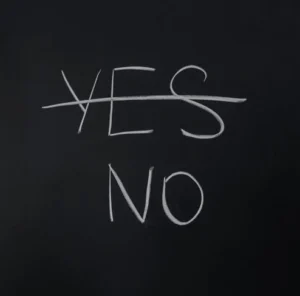Say NO (more often)
Habit Card
Click on the box
Click on the box
Weekly Review
Advice on setting realistic and achievable goals, even in high-pressure environments.
Overcoming Anxiety at Work
Summary: Strategies for reducing workplace anxiety and creating a secure environment for all employees
Main Outcome: Reduced workplace anxiety
Top Benefit(s): Improved overall mental health and productivity
Next Steps: Implement stress-reduction techniques and monitor their effectiveness
Time to Complete: 30 minutes
Target Audience: All employees, Mental health advocates
 Why it works
Why it works 
Before:
Saying “no” is a critical skill for maintaining focus, energy, and alignment with your priorities. Many professionals struggle with this due to fear of disappointing others, fear of missing opportunities, or an ingrained habit of people-pleasing. However, every “yes” to something misaligned with your goals is a “no” to something that truly matters.
After:
This post will help you develop the confidence and clarity to say “no” effectively while maintaining strong relationships and professional credibility. So by saying NO more often in a way that protects the safety of your relationships, you have more time for your priorities, therefore your delivery and performance increase which feeds the vertuous cycle of Saying NO more often.

 TO DO
TO DO 
Pause Before Responding
- When asked to commit to something, resist the urge to answer immediately.
- Take a deep breath and say, “Let me check and get back to you.”
Use a Default No
- Have a go-to phrase like, “I appreciate the opportunity, but I can’t take this on right now.”
Clarify Your Priorities
- Before the next workday, list your top 3 priorities. When a new request arises, check if it aligns.
Practice with Low-Stakes Scenarios
- Start saying “no” in minor situations (e.g., declining extra work at a restaurant or skipping a social event you don’t enjoy).
Set Up a Buffer
- Use a scheduling rule, like “No new commitments on Fridays” or “No meetings before 10 AM,” to create automatic boundaries.
 NOT DO
NOT DO 
Don’t Over-Explain
- A concise “no” with a brief reason is more effective than long justifications.
Don’t Say Yes Out of Guilt
- Feeling guilty is not a valid reason to take on extra work.
Don’t Delay the Inevitable
- If you know you need to decline, do it quickly and respectfully rather than procrastinating.
Don’t Apologize for Prioritizing
- You have the right to manage your time and energy without guilt.
- Eventually / during your Year End review, your raise, promotion, … will be decided on your overarching goals delivery
Don’t Use Soft No’s
- Phrases like “maybe later” or “I’ll try” invite follow-ups. Be clear.
 Example
Example 
Video to be uploaded
 Your next 2 weeks steps
Your next 2 weeks steps 
Start NOW or schedule your first try:
- Apply TO DO right away (<5 minutes)
- Once done, decide your commitment for the next 2 weeks
- How are you feeling right after? Compared to before? What was the value for you?
- What to adjust for you to commit for 2 weeks?
- Visualize the next time you apply it and how you would like to feel
- Celebrate that you have tried something new
2 Week plan proposal:
- Week 1: Awareness & Small Steps; every morning for under 5 minutes, think of your upcoming day:
- Reflect on the “NO” you said on the last day, and visualize how you would want to feel next time instead.
- Identify 3 situations where you typically say “yes” when you should say “no.”
- Write down your default “no” response and practice saying it out loud.
- Visualize yourself pausing before responding to any new requests.
- Week 2: Implement & Strengthen; every morning for under 5 minutes, think of your upcoming day:
- Reflect on the “NO” you said on the last day, and visualize how you would want to feel next time instead.
- What opportunity today to say “no” using a confident but kind approach?
- Set and share with a peer or your manager 3X+ personal boundary rules (e.g., “No meetings before noon”…).
- Visualize yourself applying the above and it makes you feel compared to how you would like to feel instead.
Build your habit (-> more practice -> more results)
- Model: After [OTHER CURRENT HABIT] and at/when [TIME], I will [NEW HABIT] in [LOCATION].
- Example: Before I go into a meeting, or during my Daily Planning Review, I visualize 1) my current priorities; 2) what others could ask me, that I would want to Say “NO” to, and 3) myself saying “NO” to the ask, and feeling good about it.
- Print your sticky habit
Total time:
5m/day X 8 = 40 minutes in 2 weeks
How you measure success:
Have applied at least 8X times in the next 2 weeks
What value you can expect:
More time available for your priorities; prouder about yourself for the courage to say NO while maintaining safety; stronger relationships with others
How to get started:
Print and fill your Habit template then apply right away
 With more time
With more time 
Apply more often
Learn more:
on this subject
Morning Visualization Routine
Evening Visualization Routine
Reset routine





